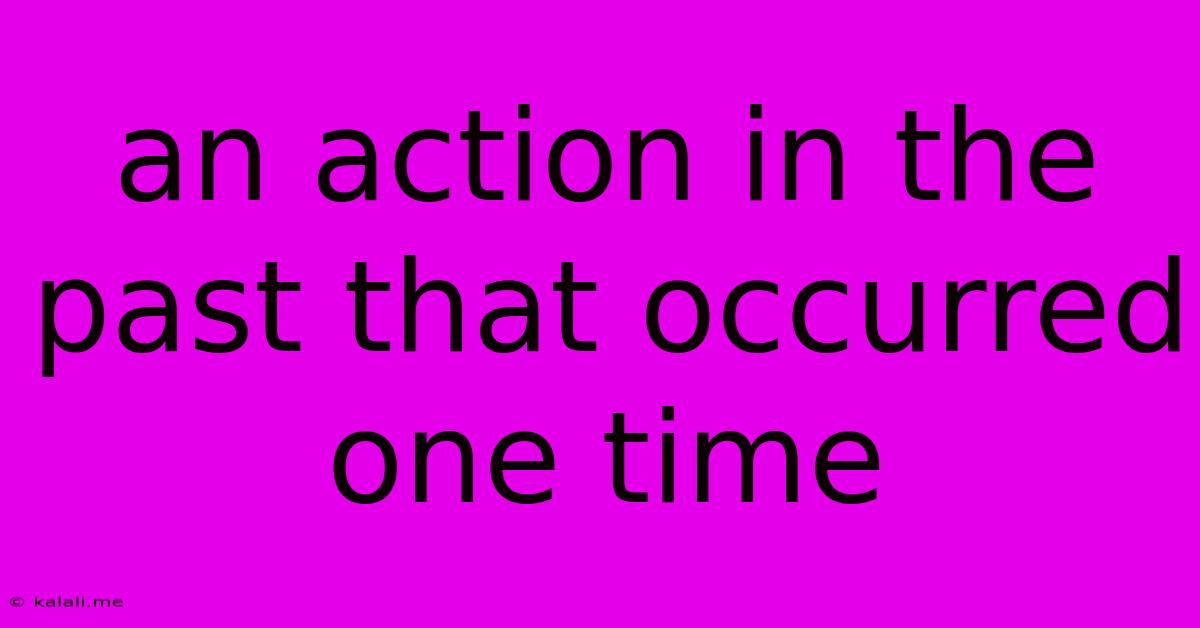An Action In The Past That Occurred One Time
Kalali
Jun 06, 2025 · 3 min read

Table of Contents
The Simple Past Tense: Narrating Single Past Events
This article will explore the simple past tense in English, focusing on its crucial role in describing actions that happened only once in the past. We'll cover its formation, usage, and provide examples to help you master this fundamental grammatical structure. Understanding the simple past is key to writing clear and effective narratives, whether you're crafting a blog post, a story, or simply recounting a personal anecdote.
The simple past tense is used to talk about completed actions that happened at a specific time in the past and are now finished. It's the go-to tense for describing events that occurred only once, without any implication of repetition or continuation. Think of it as the building block for recounting singular past experiences.
Forming the Simple Past Tense: Regular and Irregular Verbs
Most regular verbs form the simple past by adding "-ed" to the base form. For example:
- Walk: I walked to the store yesterday.
- Talk: We talked for hours.
- Play: She played the piano beautifully.
However, English boasts a large number of irregular verbs, which don't follow this simple rule. These verbs have unique past tense forms that need to be memorized. Some common examples include:
- Go: I went to the beach.
- Eat: He ate all the cake.
- See: They saw a beautiful sunset.
- Be: She was happy. (Note the different forms of "to be" in the past tense)
A complete list of irregular verbs can be found in many grammar resources. Mastering these irregular verbs is crucial for fluent and accurate English writing.
Using the Simple Past Tense Effectively: Context is Key
The context in which you use the simple past tense is vital. It's not just about the verb; it's about how you set the scene and provide the reader with a clear understanding of when the single event happened.
Consider these examples:
- Specific Time: "I visited the Eiffel Tower on my trip to Paris in 2018." (Clearly indicates a single past event at a specific time)
- Unspecified Time: "I read a fascinating book last week." (Implies a single completed action within a defined timeframe)
- Sequence of Events: "First, I woke up, then I made breakfast, and finally I left for work." (Shows a series of single past events in chronological order)
Beyond the Basics: Adding Depth and Detail
To make your writing more engaging and vivid, use descriptive language alongside the simple past tense. Include details about the setting, the people involved, and the emotions experienced.
For instance, instead of writing "I saw a bird," try: "A brilliant blue jay, its feathers gleaming in the morning sun, landed on the branch outside my window." The added details paint a much richer picture for the reader.
Conclusion: Mastering the Simple Past for Clear and Engaging Narratives
The simple past tense is a fundamental element of English grammar, essential for accurately and effectively describing single past events. By understanding its formation, usage, and incorporating descriptive language, you can elevate your writing, making your narratives more engaging and easier for your audience to understand. Practice using it in your writing, focusing on clear time indicators and vivid descriptions, and you'll quickly master this crucial aspect of English grammar.
Latest Posts
Latest Posts
-
How Long Does It Take For Thinset To Dry
Jun 06, 2025
-
Blender Texture Paint Not Working On Some Faces
Jun 06, 2025
-
Can You Create Clipping Masks With Pngs
Jun 06, 2025
-
How To Remove Moss From Brick
Jun 06, 2025
-
2007 Honda Shadow Aero Gas Tank Capacity In Litres
Jun 06, 2025
Related Post
Thank you for visiting our website which covers about An Action In The Past That Occurred One Time . We hope the information provided has been useful to you. Feel free to contact us if you have any questions or need further assistance. See you next time and don't miss to bookmark.